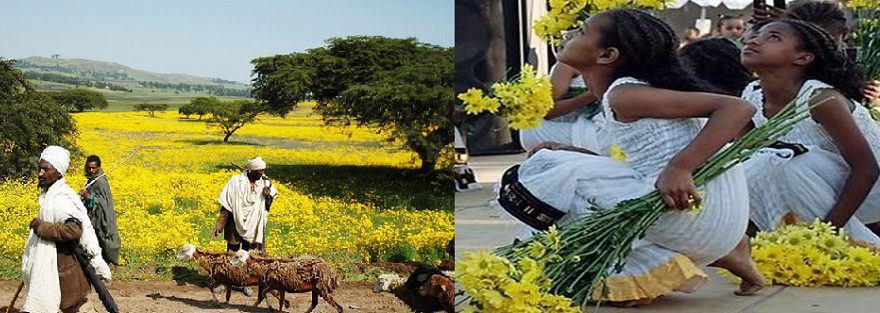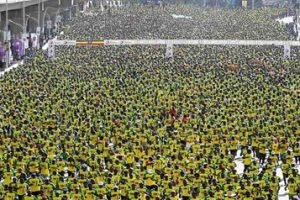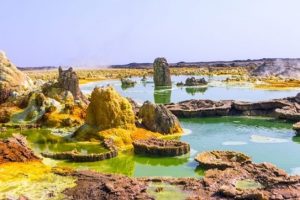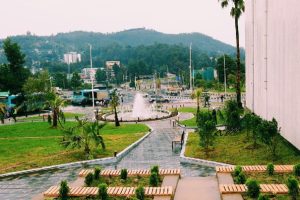
BY ELIZABETH MENGISTU
Ethiopians will celebrate their New Year, 2014, on September 11, 2022. Saying goodbye to the darkest, thunderous, rainy and windy season, Ethiopians will receive the brightest and sunniest season, Meskerem, which is the first month of the year in the Ethiopian calendar, and celebrate Enkutatash.
Meskerem, for Ethiopians is the month in which the rainy season comes to an end and the sunny season begins. It is a month that flowers blooms and the Ethiopian mountains, hills, plains and plateaus turn green. During September, the landscape is covered with the mass blooming of the bright yellow flower known as Adey Abeba.
Not only has that, following the end of the darkest month and the arrival of the bright season, new hope grows and bright aspiration stimulated in the minds of all, regardless of any differences. People, who could not visit their families and relatives for months owing to the river water overflows, aspire to visit them. During Meskerem, Ethiopians, living abroad, are also returning home to celebrate the New Year along with their families.
With greater eagerness, school students prepare themselves to start their schooling and to see their closest friends. In Meskerem, many people set plans to be realized on the subsequent months. During New Year, it is common for many people to make promises to stop unhealthy/bad habits such as chewing chat, smoking or drinking alcohol.
The festivity of Enkutatash (which means the “gift of jewels” and has been celebrated for centuries) is celebrated with various events, including family gatherings, singing and dancing, enjoying a traditional Enkutatash meal and homemade drink; and by giving children gifts.
Few days before the actual festival, Ethiopians start preparation. They go out for shopping, buy materials which are important and add more atmospheres for the festival, including cultural attires depending on their economic status.
The celebrations of the day start on the eve of Enkutatash on which people burn torches (Chibbo made out of bundle of dry sticks); and many families attend a church service and offer prayers; adorned by Ethiopian cultural dresses.
Children, creating a group, (always young girls) embellished with traditional dresses and holding Adey Abeba sing New Year’s song moving from one house to another in their neighborhood. Boys, on the other way, around by painting images of saints and flowers on papers, give to their families and neighborhoods as an expression of good wishes. In turn, they receive whatever given to them as gifts.
Meskerem 1, the first of the thirteen months of the Ethiopian calendar and heralds the beginning of the New Year, is though celebrated warmly and colorfully, the month is always seen as a busy time and a unique month among Ethiopians. The Meskel (the Finding of the True Cross), the festival celebrated to commemorate the finding of the actual cross on which Jesus was crucified and the Irreecha festival which is the Thanksgiving festival of the Oromo people are also the other features that make the month Meskerem special.
As Nebeyou Ambachew stated in a piece titled “It is Time for Ethiopian New Year,” September is a wonderful time in Ethiopia and particularly the Ethiopian month of Meskerem that runs from 11th or 12th September to 10th October marking the beginning of the Ethiopian year. The countryside is lit up with the masses of bright yellow Meskel daisies and more sunshine flickering through the rain clouds, and it brings with it all the promise of the New Year.
The story of Enkutatash goes back almost 3,000 years to the Queen of Sheba of ancient Ethiopia who was returning from a trip to visit King Solomon of Israel in Jerusalem, She had gifted Solomon with 120 talents of gold (4.5 tons) as well as a large amount of unique spices and jewels. When the Queen returned to Ethiopia her chiefs welcomed her with Enku or jewels to replenish her treasury, he wrote referring to the Holy Book.
And Enkutatash is an important festival for Ethiopians as it also symbolizes the advent of good harvest weather. After months of torrential pour, the month of September sees clear skies and fresh water, beautiful atmosphere. The highlands all teeming with flowers and the land looks like it is made of clear gold as the Meskel daisies bear flowers on the season, he added.
True, Meskerem is the brightest month of the year that Ethiopians, from different religious and cultural backgrounds, celebrate it with positive spirit and hoping the best in the future.
The outgoing year, 2014, has not been a good year for Ethiopia and Ethiopians. Rather, it has been one of the worst years that Ethiopians have witnessed a number of unpleasant incidents; and gone through various awkward situations forcibly.
As President Sahle-Work Zewde stated in relation to “Peace Day” celebrated yesterday, peace is expensive; and we Ethiopians need more than anything peace, not war.
The President highlighted that peace is the result and process of all efforts. Since, we are the ones who can create peace, the participation and effort of all Ethiopians is critical. For this best reason, in the effort exerted to maintain peace, security and instability throughout the country, the contribution and commitment of all Ethiopians is central, as the President stated.
And, we, Ethiopians, while welcoming in the New Year, 2015, we hope for the best and wish to see a peaceful, united and prosperous Ethiopia where its citizens united in differences and diversity and live together peacefully putting aside all their differences.
The Ethiopian Herald September 9/2022





